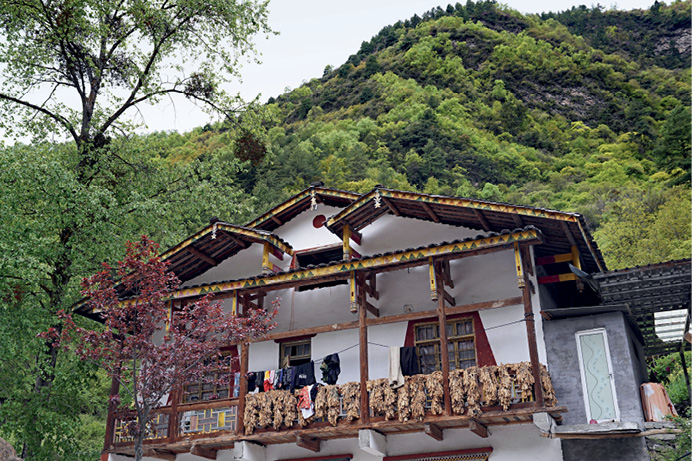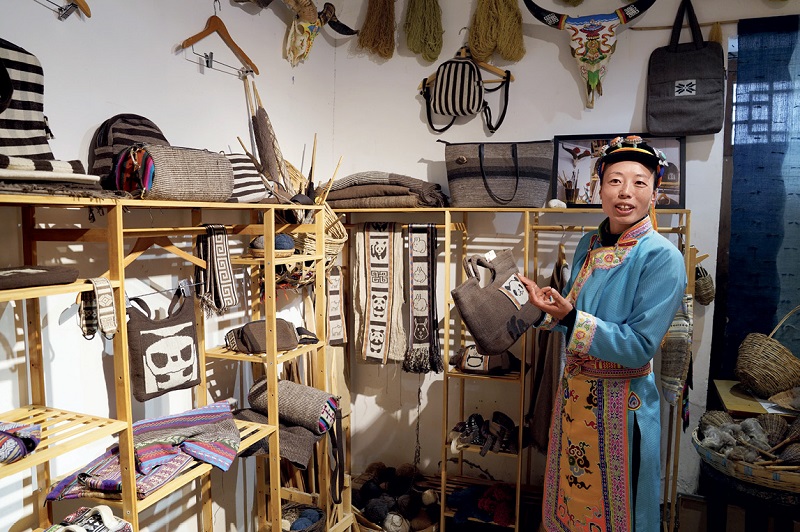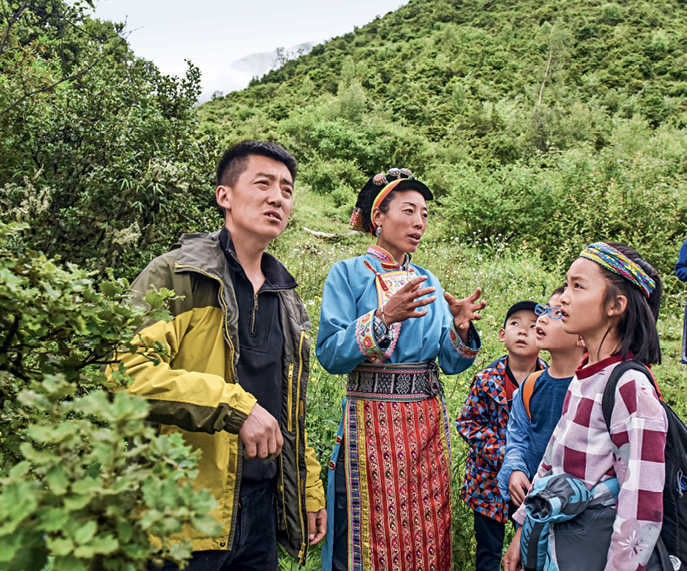
Yaoji, meaning “a very high place” in Tibetan language, is a Tibetan township in Ya’an, Sichuan Province in southwest China. Situated at an altitude of 2,500 meters above sea level in the snow-capped Jiajin Mountains, the township has preserved the historical traditions of Jiarong Tibetans, a branch of the Tibetan ethnic group, and is a core area of the Giant Panda National Park.
The park was established in October 2021, three months after the giant panda was downgraded to “vulnerable” from “endangered” on the global list of species at risk of extinction. More than 95 percent of Yaoji’s land is included in the park, making it a veritable “panda village.”
The protection of giant pandas for many years has brought changes in Yaoji. Ecological conservation has become an inseparable part of the routine life and work of the villagers, while the giant panda fever has helped to protect and pass on the traditional culture of the Jiarong Tibetan people as the region continues to draw tourists and visitors.
Protecting the mountains
In the village of Jiajinshan in Yaoji, a traditional Tibetan-style house is often filled with laughter. It is where 38-year-old villager Nengkaman and her husband run their agritainment business.
“When the agritainment business first opened, many people in the village doubted whether it would succeed. They wondered why someone would visit this remote place,” Nengkaman said. However, after the establishment of Giant Panda National Park, more and more people began visiting the area to see the giant pandas.
Visitors typically come with their children during summer and winter holidays. The couple takes them deep into the mountains to learn about giant pandas, as well as about other animals and plants, and tips to survive in the wild. Nengkaman serves as both their guide and educator about nature.
“I accompany them to look for droppings and footprints of giant pandas and help them learn about this beautiful mountain and the vegetation and rivers of the area,” she said. “I love all the creatures here, and hope more people will fall in love with them.”
With the support of the local government, more and more villagers like Nengkaman have started their agritainment business. According to Wang Dan, deputy head of the township government, the excellent ecological resources in the village have helped the area to become a special scenic spot with more than 170 Tibetan agritainment entities of the Jiarong Tibetan style. However, just a few years ago, the villagers’ main source of income was animal husbandry.
For Jiarong Tibetans, who live a mixed agricultural and pastoral way of life, the yak is a symbol of wealth. The foot of Jiajin Mountains was once home to more than 30,000 free-ranging yaks. However, as the yak population spiked beyond the pasture’s capacity, the villagers became aware that there was not enough food for their cattle.
“They then realized that lucid water and lush mountains are all gifts from nature, and that depending entirely on raising yaks for a living was not sustainable. Only by loving and protecting the mountain can we embark on a sustainable development path,” said Yang Hao, secretary of Yaoji Township Committee of the Communist Party of China.
With the constant presence of giant pandas, villagers began to shift their approach to development by limiting the number of yaks to make room for pandas. Yang said that in recent years, the villagers have become increasingly aware of the importance of protecting the environment. According to him, Yaoji has put the protection of pandas into village rules and regulations, and the total number of yaks in the township has reduced by around 10,000.
Today, as one of the places where pandas are most frequently seen, the township has drawn the attention of the outside world with more and more people visiting this area. To seize the opportunity and make full use of local ecological resources, the township government has led the villagers to develop tourism and further increase their income by launching deep processing of yak products. Tourism and animal husbandry are now playing equally important roles in bringing wealth to the villagers through green development.

Nengkaman shows a bag she made at her workshop in the township of Yaoji, Ya’an City, Sichuan Province in southwest China, on May 9. Yu Xiangjun
Preserving traditional arts
After the yak hair is shorn, it is turned into thread and then woven into fabric, which then is used to make finished products. This is how the thin and soft yak hair is turned into woven bags with cute panda patterns.
Among her multiple identities, Nengkaman is an inheritor of the patterned belt weaving technique, a national intangible cultural heritage and part of the ancient weaving technique unique to the Jiarong Tibetan people. With the techniques, yak hair is repeatedly twisted by the Tibetan women and turned into fabric with the help of weaving tools.
The number of people who have mastered this skill is declining because the skill is passed on from person to person, instead of being taught in a school or institution. This and the impact of modern industrialization have put the technique at risk. Nengkaman was worried that this traditional skill would die out.
In 2016, she set up a handicraft workshop and invited a dozen women from the village to join her. Together, they explored ways to improve and innovate their skills in their spare time. They cleverly incorporated the panda element into backpacks, shawls, scarves, pendants, and other woven items, and these handmade products have become a big hit on online platforms.
“If we turn skills into commodities of value, more people will accept it, and in the process, more people will be interested in learning it,” she said.
The weaving work has changed the life of the women in the village. “With the increase in income, the life and outlook of women in the village have changed a lot. They have more confidence in traditional Tibetan culture and in creating a better life through their own labor,” she said.

Nengkaman (second left) and her husband (first left) serve as tour guides to children in the township of Yaoji, Ya’an City, Sichuan Province in southwest China, on July 6, 2018. Yang Tao
Opening a window
The vibrant sea of flowers in spring, the lushness of summer, the flaming red leaves in autumn, and the magnificent snow-covered meadows in winter — these are the characteristics of the four seasons of the Jiajin Mountain area as seen by Nengkaman.
In 2014, the From Our Eyes charity project, an initiative of Yunnan Province to encourage villagers to film their hometown, launched an activity to provide free videography training to rural women. Nengkaman, who had attended two years of senior high school, was selected for the project. For the first time in her life, she picked up a camera and began to document her beautiful hometown. She was the first person in the area to make a documentary film.
Her work Sertarmailong, named after a sacred local mountain, presents the magnificent scenery of snow-capped mountains and records the yak shearing festival in Yaoji. The documentary was shown at national and international film festivals, serving as a window for more people to learn about the township and the “panda village” under the snowy mountains.
“I’ve been in the mountains and in the city, and used to long for city life; but over the years I’ve realized that each has its own merits,” she said. “The landscape here has nurtured us, and my love for my hometown has always remained the same.” Over the past 10 years, she has filled seven hard drives with four terabytes of footage, making her a witness to the harmony between local people and wildlife.
Currently, a brand-new building is under construction next to Nengkaman’s agritainment business. When completed, it will be used as a museum for folklore heritage and village videography to further promote local nature education, traditional handicraft studies and so on. All the images Nengkaman has collected of her hometown will be exhibited there, allowing more people to hear the stories behind the Tibetan township’s coexistence with nature, pandas in particular.